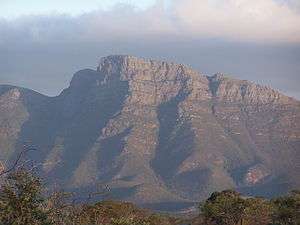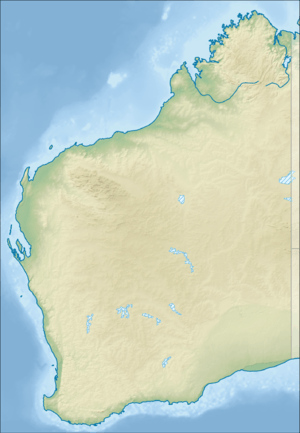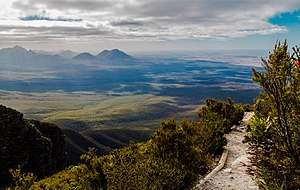Bluff Knoll
Bluff Knoll is the highest peak of the Stirling Range in the Great Southern region of Western Australia (WA). It is 1,099 metres (3,606 ft) above sea level,[1] Although Bluff Knoll is sometimes claimed to be the highest point in Western Australia,[2] the highest peak is actually Mount Meharry in Karijini National Park in the Hamersley Range, which is 1,249 metres (4,098 ft) above sea level.
| Bluff Knoll | |
|---|---|
 | |
| Highest point | |
| Elevation | 1,099 m (3,606 ft) [1] |
| Prominence | 650 m (2,130 ft) |
| Coordinates | 34°22′32″S 118°15′22″E [1] |
| Geography | |
 Bluff Knoll Great Southern of Western Australia | |
| Parent range | Stirling Range |
Local Aboriginal people, from the Qaaniyan and Koreng groups (or tribes), who wore kangaroo skin cloaks in cold weather, called the mountain Pualaar Miial, meaning "great many-faced hill"[3] or place of "many eyes". The Noongar people treat it with foreboding and prefer to avoid its rocky ridges, which are woven with tales of malevolent witches.[4] The mountain is often shrouded in a mist which curls around the peaks and floats into the gullies. Local people believed this to be a spirit named Noatch (literally meaning "dead body" or "corpse").[3]
Climbing Bluff Knoll, a round trip of about 6 kilometres (3.7 mi), takes three to four hours,[3] and can be achieved by anyone with a reasonable level of fitness.

The view from the summit encompasses the Stirling and Porongurup mountain ranges, as well as the coast near Albany.
The lower slopes are dominated by young Eucalypts which can catch fire following lightning strikes such as one that set the forest alight in 2010.[4]
The mountain as well as the rest of the Stirling Range were formed as Australia broke away from Antarctica. When both the continents began to separate a rift gradually opened. In the first stage of rifting, it began to open in the west, then later the eastern section began to open. The two continents pivoted slightly at a point in the west, which squeezed the sediments at the western end of the break against the Yilgarn block, which forced the sediments up to form the range. The sedimentary rocks that were folded up are 1.2 billion years old. The rocks on the range are mostly sedimentary such as sandstone, quartzite, slate and shale.[5]
The peak was given its name by Governor James Stirling as the highest point in the Stirling Range.[2]
Climate
Bluff Knoll is one of only a few places to experience regular snowfalls in Western Australia, with some snow reported in most years.
Snow on April 20, 1970 was recorded in Bureau of Meteorology (BOM) records. A heavy snowfall was recorded on 6 October 1992 when 20 centimetres of snow fell and light snow was seen at the base, at 450 metres (1,480 ft). Snow fell on three occasions in 2016 after only falling once in 2015.[6]
A flurry was recorded on the peak after 2:00pm on April 19, 2019. It was the earliest recorded snow event in a calendar year in the history of WA.
References
| Wikimedia Commons has media related to Bluff Knoll, Stirling Range. |
- "Bluff Knoll". Gazetteer of Australia online. Geoscience Australia, Australian Government.
- "Western Australian names". Sunday Times (Perth) (1568). Western Australia. 12 February 1928. p. 24. Retrieved 17 April 2017 – via National Library of Australia.
- Brad Barber (13 November 2002). "Climbing Bluff Knoll". ABC South Coast WA. Australian Broadcasting Corporation. Archived from the original on 3 February 2008. Retrieved 25 November 2010.
- "Walking in Australia: Climbing Bluff Knoll, the 'peak with many eyes'". The Telegraph. Telegraph Media Group Limited. 2017. Retrieved 17 April 2017.
- M.H.Monroe. "Stirling Range Koi Kyeunu-ruff, Western Australia". Australian through time. Retrieved 17 April 2017.
- Andrew Collins (9 August 2016). "Snow falls on Bluff Knoll as hikers brave freezing temperatures". Australian Broadcasting Corporation. Retrieved 17 April 2017.